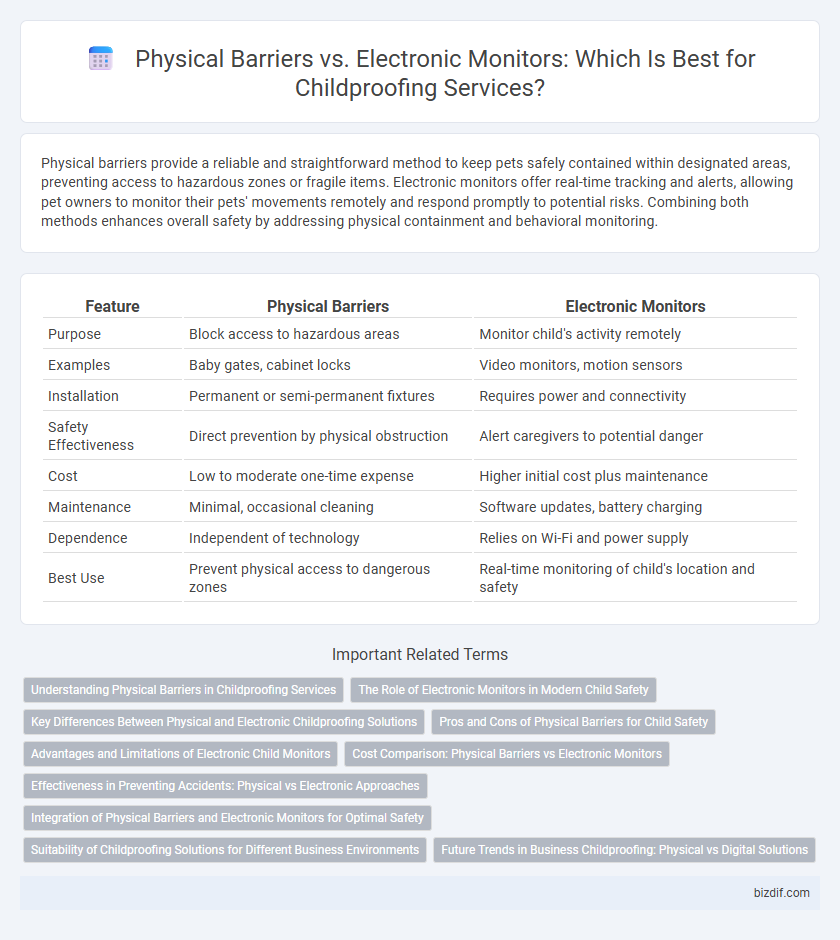Physical barriers provide a reliable and straightforward method to keep pets safely contained within designated areas, preventing access to hazardous zones or fragile items. Electronic monitors offer real-time tracking and alerts, allowing pet owners to monitor their pets' movements remotely and respond promptly to potential risks. Combining both methods enhances overall safety by addressing physical containment and behavioral monitoring.
Table of Comparison
| Feature | Physical Barriers | Electronic Monitors |
|---|---|---|
| Purpose | Block access to hazardous areas | Monitor child's activity remotely |
| Examples | Baby gates, cabinet locks | Video monitors, motion sensors |
| Installation | Permanent or semi-permanent fixtures | Requires power and connectivity |
| Safety Effectiveness | Direct prevention by physical obstruction | Alert caregivers to potential danger |
| Cost | Low to moderate one-time expense | Higher initial cost plus maintenance |
| Maintenance | Minimal, occasional cleaning | Software updates, battery charging |
| Dependence | Independent of technology | Relies on Wi-Fi and power supply |
| Best Use | Prevent physical access to dangerous zones | Real-time monitoring of child's location and safety |
Understanding Physical Barriers in Childproofing Services
Physical barriers in childproofing services provide tangible safeguards like safety gates, cabinet locks, and door knob covers that prevent children from accessing hazardous areas. These barriers create a direct and consistent obstacle, reducing the risk of injury by physically restricting movement in high-risk zones. Unlike electronic monitors, physical barriers require no power source and offer continuous protection without the need for active supervision.
The Role of Electronic Monitors in Modern Child Safety
Electronic monitors play a crucial role in modern child safety by providing real-time alerts and continuous monitoring that physical barriers alone cannot offer. Devices such as baby monitors, smart sensors, and wearable trackers enable parents to remotely oversee their child's activities and quickly respond to potential hazards. Integrating these technologies into childproofing strategies enhances overall protection and peace of mind for caregivers.
Key Differences Between Physical and Electronic Childproofing Solutions
Physical barriers, such as safety gates and cabinet locks, provide tangible, immediate prevention by creating direct obstacles that restrict children's access to hazardous areas. Electronic monitors use sensors and alarms to detect movement or proximity, offering remote oversight and real-time alerts without physically blocking access. Key differences include the necessity of physical presence for barriers versus the technological reliance on batteries and devices for monitors, affecting installation complexity and ongoing maintenance.
Pros and Cons of Physical Barriers for Child Safety
Physical barriers, such as safety gates and cabinet locks, provide a tangible and immediate way to prevent children from accessing hazardous areas, ensuring consistent protection without reliance on technology. These barriers are durable, require minimal maintenance, and do not emit signals that could interfere with other devices or be bypassed by tech-savvy children. However, physical barriers can be cumbersome to install, may limit adult access convenience, and sometimes fail to address hazards that are not confined to specific zones, unlike electronic monitors that offer real-time alerts and remote supervision.
Advantages and Limitations of Electronic Child Monitors
Electronic child monitors offer real-time audio and video surveillance, providing parents with immediate alerts and remote access to their child's activity, enhancing safety and peace of mind. Their limitations include dependency on Wi-Fi connectivity, potential technical malfunctions, and privacy concerns due to hacking risks. Unlike physical barriers, electronic monitors do not prevent access but serve as a supplementary oversight tool, making them ideal for monitoring but insufficient alone for complete childproofing.
Cost Comparison: Physical Barriers vs Electronic Monitors
Physical barriers such as safety gates and cabinet locks typically involve a one-time purchase cost ranging from $20 to $100 per item, offering durable and low-maintenance protection. Electronic monitors, including baby monitors and motion sensors, often require an initial investment of $50 to $200 plus ongoing expenses for batteries or subscriptions. Choosing physical barriers can be more cost-effective for long-term childproofing, while electronic monitors provide added convenience and real-time alerts but at a higher cumulative cost.
Effectiveness in Preventing Accidents: Physical vs Electronic Approaches
Physical barriers provide a direct and reliable method to prevent children from accessing hazardous areas, effectively reducing accidents by creating tangible obstructions. Electronic monitors offer real-time alerts and monitoring capabilities but rely on caregiver response time and can sometimes fail due to technical issues. Combining both approaches enhances overall childproofing effectiveness by balancing prevention and active supervision.
Integration of Physical Barriers and Electronic Monitors for Optimal Safety
Integrating physical barriers such as safety gates and cabinet locks with electronic monitors like motion sensors and alarms creates a comprehensive childproofing system that enhances home safety. Physical barriers provide immediate, tangible obstruction to hazardous areas, while electronic monitors offer real-time alerts and remote supervision, allowing for proactive prevention of accidents. This combination ensures layered protection by addressing both physical access and continuous monitoring, significantly reducing risks of child injuries.
Suitability of Childproofing Solutions for Different Business Environments
Physical barriers such as safety gates and door locks provide durable and reliable childproofing solutions ideal for retail stores, daycare centers, and medical offices with high foot traffic. Electronic monitors, including motion sensors and video surveillance, offer advanced supervision suitable for environments requiring real-time alerts, like corporate offices and educational institutions. Selecting the right childproofing method depends on the specific business setting's layout, activity level, and safety priorities to ensure optimal protection and compliance with safety standards.
Future Trends in Business Childproofing: Physical vs Digital Solutions
Future trends in business childproofing emphasize the integration of physical barriers with advanced electronic monitors, creating hybrid safety solutions. Smart sensors, AI-powered alerts, and IoT-enabled devices enhance real-time monitoring while maintaining the reliability of traditional gates and locks. This convergence of physical and digital technologies promises increased efficiency and customizable child safety options for modern families and businesses.
Physical barriers vs Electronic monitors Infographic

 bizdif.com
bizdif.com